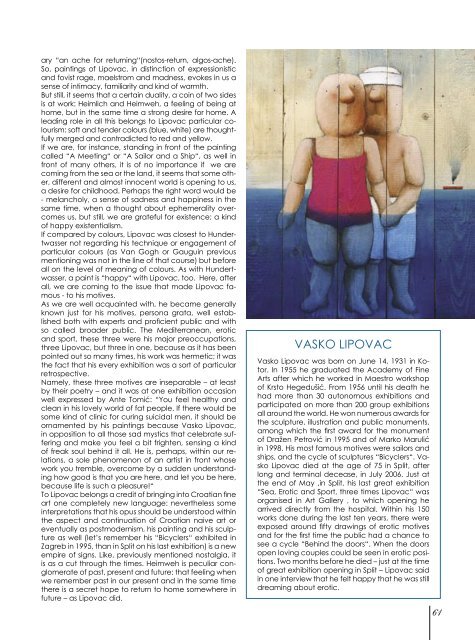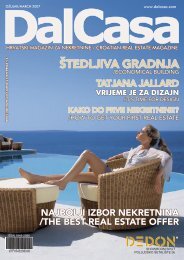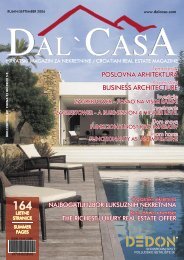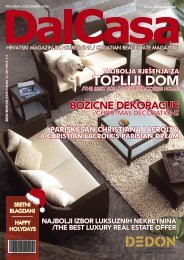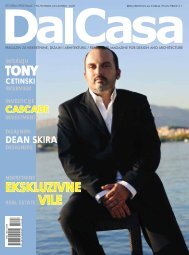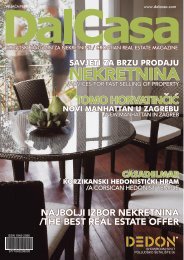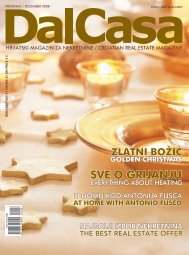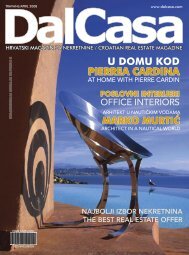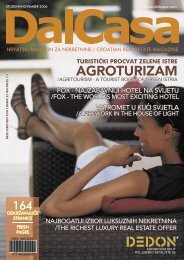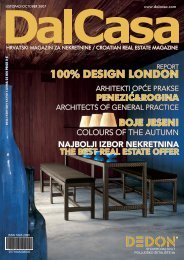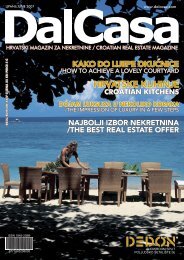MAISON&OBJET; - DalCasa
MAISON&OBJET; - DalCasa
MAISON&OBJET; - DalCasa
- No tags were found...
You also want an ePaper? Increase the reach of your titles
YUMPU automatically turns print PDFs into web optimized ePapers that Google loves.
ary “an ache for returning“(nostos-return, algos-ache).So, paintings of Lipovac, in distinction of expressionisticand fovist rage, maelstrom and madness, evokes in us asense of intimacy, familiarity and kind of warmth.But still, it seems that a certain duality, a coin of two sidesis at work: Heimlich and Heimweh, a feeling of being athome, but in the same time a strong desire for home. Aleading role in all this belongs to Lipovac particular colourism:soft and tender colours (blue, white) are thoughtfullymerged and contradicted to red and yellow.If we are, for instance, standing in front of the paintingcalled “A Meeting“ or “A Sailor and a Ship“, as well infront of many others, it is of no importance if we arecoming from the sea or the land, it seems that some other,different and almost innocent world is opening to us,a desire for childhood. Perhaps the right word would be- melancholy, a sense of sadness and happiness in thesame time, when a thought about ephemerality overcomesus, but still, we are grateful for existence; a kindof happy existentialism.If compared by colours, Lipovac was closest to Hundertwassernot regarding his technique or engagement ofparticular colours (as Van Gogh or Gauguin previousmentioning was not in the line of that course) but beforeall on the level of meaning of colours. As with Hundertwasser,a paint is “happy“ with Lipovac, too. Here, afterall, we are coming to the issue that made Lipovac famous- to his motives.As we are well acquainted with, he became generallyknown just for his motives, persona grata, well establishedboth with experts and proficient public and withso called broader public. The Mediterranean, eroticand sport, these three were his major preoccupations,three Lipovac, but three in one, because as it has beenpointed out so many times, his work was hermetic; it wasthe fact that his every exhibition was a sort of particularretrospective.Namely, these three motives are inseparable – at leastby their poetry – and it was at one exhibition occasionwell expressed by Ante Tomić: “You feel healthy andclean in his lovely world of fat people. If there would besome kind of clinic for curing suicidal men, it should beornamented by his paintings because Vasko Lipovac,in opposition to all those sad mystics that celebrate sufferingand make you feel a bit frighten, sensing a kindof freak soul behind it all. He is, perhaps, within our relations,a sole phenomenon of an artist in front whosework you tremble, overcome by a sudden understandinghow good is that you are here, and let you be here,because life is such a pleasure!“To Lipovac belongs a credit of bringing into Croatian fineart one completely new language: nevertheless someinterpretations that his opus should be understood withinthe aspect and continuation of Croatian naive art oreventually as postmodernism, his painting and his sculptureas well (let’s remember his “Bicyclers“ exhibited inZagreb in 1995, than in Split on his last exhibition) is a newempire of signs. Like, previously mentioned nostalgia, itis as a cut through the times. Heimweh is peculiar conglomerateof past, present and future: that feeling whenwe remember past in our present and in the same timethere is a secret hope to return to home somewhere infuture – as Lipovac did.VASKO LIPOVACVasko Lipovac was born on June 14, 1931 in Kotor.In 1955 he graduated the Academy of FineArts after which he worked in Maestro workshopof Krsto Hegedušić. From 1956 until his death hehad more than 30 autonomous exhibitions andparticipated on more than 200 group exhibitionsall around the world. He won numerous awards forthe sculpture, illustration and public monuments,among which the first award for the monumentof Dražen Petrović in 1995 and of Marko Marulićin 1998. His most famous motives were sailors andships, and the cycle of sculptures “Bicyclers“. VaskoLipovac died at the age of 75 in Split, afterlong and terminal decease, in July 2006. Just atthe end of May ,in Split, his last great exhibition“Sea, Erotic and Sport, three times Lipovac“ wasorganised in Art Gallery , to which opening hearrived directly from the hospital. Within his 150works done during the last ten years, there wereexposed around fifty drawings of erotic motivesand for the first time the public had a chance tosee a cycle “Behind the doors“. When the doorsopen loving couples could be seen in erotic positions.Two months before he died – just at the timeof great exhibition opening in Split – Lipovac saidin one interview that he felt happy that he was stilldreaming about erotic.61


